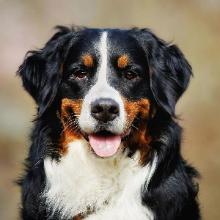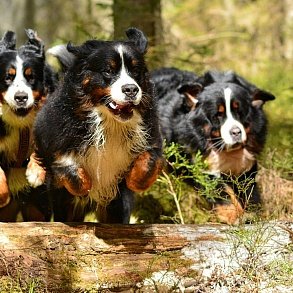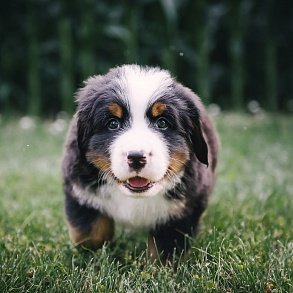Bernese Mountain Dog

Bernese Mountain Dog (Bernese Shepherd) is an affectionate and charming giant with the most good–natured "smile" in the world. Representatives of this breed are ideal companions with an innate sense of tact and an unusually peaceful character.
- Brief information
- Highlights
- Breed characteristics
- History of the Bernese Mountain Dog breed
- Appearance of Bernese mountain dogs
- The character of the Bernese Mountain Dogs
- Education and training
- Care and maintenance
- Health and diseases of the Bernese Mountain Dog
- How to choose a puppy
- How much does the Bernese Mountain Dog cost
Brief information
- Breed name: Bernese Mountain Dog
- Country of Origin: Switzerland
- The time of the birth of the breed: 1910
- Weight: males 39-50 kg, females 36-48 kg
- Height (height at the withers): males 64-70 cm, females 58-66 cm
- Life expectancy: 8 – 10 years
Highlights
- Despite their impressive size, Bernese mountain dogs get along well in apartments.
- Dogs of this breed grow for a relatively long time and finally mature only by the age of 2.
- They get along with other pets without any problems, and they are able to maintain truly friendly relations with cats.
- Bernese mountain dogs favorably accept the owner's attention, but begging for affection is not in their rules.
- They perceive walking on a leash well, but the chain and life in the aviary do not suit them.
- They learn quickly and willingly follow commands, although they are somewhat inferior in intelligence and discipline to other shepherds.
- Some individuals tend to show slight stubbornness, which can sometimes slow down the training process.
- Berns have a thick long coat and shed intensively throughout the year.
- Need good walking and regular exercise.
Bernese Mountain Dogs - dogs are kind-hearted and loyal helpers. They get along excellently with every member of the family, and the kids are condescendingly forgiven for any mischief. Patience and poise have turned the Berns into almost perfect pets. They are not capricious in learning and easily assimilate commands. In addition, they inherited excellent watchdog skills from their ancestors, which they enjoy using as soon as a suitable opportunity turns up.
Breed characteristics
History of the Bernese Mountain Dog breed
The Molossians, whose breeding was carried out by the ancient Romans, are considered to be the distant ancestors of today's Sennenhunds. Representatives of this breed were considered universal dogs, since each individual combined fighting, herding and watchdog qualities. Molossians accompanied the Romans in military campaigns, which helped the dogs to get to the Alps and leave offspring on the territory of modern Switzerland, which gave rise to the family branch of the mountain dogs.
Swiss peasants quickly appreciated the endurance and good-natured disposition of these large dogs, adapting them to work in cheese factories and transporting milk along mountain trails. Up until the middle of the XIX century, the mountain dogs regularly grazed cows on alpine lawns, working part-time as milk carriers, but soon enough they were ousted from this niche by St. Bernards. In some remote areas, the descendants of the Roman Molossians were still bred, but not so zealously, which is why the famous tricolor color among animals was becoming rarer.
For a long period of time, Swiss mountain dogs were equated to mongrels and were not quoted by breeders. It was only at the end of the XIX century that these dogs began to arouse the interest of specialists, which became the main impetus for the appearance of the Bernese Shepherd branch. The Burgdorf winemaker F. played a fundamental role in the formation of the breed . Schertenleib. The entrepreneur fell in love with Alpine dogs so much that he tirelessly traveled around the province of Durbach in search of suitable "specimens" for his kennel.
The name "Bernese Mountain Dog" of this branch was given by Albert Heim, a professor at the University of Zurich, who also formulated its main "identification signs". Well, in 1907, the first breed standard was adopted, which, in fact, was a pure formality. As a result, Bernese mountain dogs were exhibited for quite a long time in European salons without pedigrees and registration numbers.
Curious fact: in the 40s of the XX century, as a result of the accidental mating of the Bernese mountain dog with Newfoundland , Swiss shepherd dogs were able to improve their natural performance. For example, Bernese Shepherds have acquired a shinier and longer coat, and their temperament has become more phlegmatic.
The peak of popularity of the Berns came in the 80s of the last century. Calm and friendly shepherds enjoyed unwavering authority among European and American breeders. In Russia, the representatives of this breed were imported from Hungary, Poland, Czechoslovakia and Germany.
Video: Bernese Mountain Dog
Appearance of Bernese mountain dogs
Bernese Shepherds are rather large dogs with long black-fawn coat and white spots around the nose, neck and paws. The brand "sign" of the breed is the so-called "smile" of the Bernese. In a calm state, the muscles of the dog's muzzle and head relax, opening his mouth slightly and creating the illusion of human facial expressions. The reference height at the withers for males is from 64 to 70 cm, for females – from 58 to 67 cm. The average weight of the Bernese Mountain Dog ranges from 39-50 kg in males, 38-48 kg in females.
Head
Proportional, large. The skull is massive, rounded in shape, which is especially noticeable when looking at the animal in profile. The frontal furrow is not clearly expressed. The transition from the frontal part to the muzzle is smooth, without sharp lines. The nose is large, black, with large nostrils.
Jaws and teeth
The reference bite is scissor–like, but in some cases a tick-like (direct) variant is also acceptable. The teeth of the Bernese Mountain Dog are large, strong, arranged in one line.
Eyes
The eyes are medium, almond-shaped, set straight. The shade of the iris is dark brown, the whites of the eyes are not noticeable. The eyelids are dry, black ("raw" eyelids refer to defects).
Ears
Medium size, regular triangular shape, set high. At rest, they are hanging, the tip of the ear is slightly rounded. When the Bernese Mountain Dog is alert, the anterior part of the auricle continues to remain in a state adjacent to the skull, while its posterior part is slightly raised.
Neck
Medium length, muscular, with a prominent nape and developed withers.
Body
The body is compact, strong, with a wide straight back and a deep long chest. The ribs are convex. The loin is short, slightly narrower than the thoracic and croup parts.
Limbs
The forelimbs of the Bernese Mountain Dog are straight, even, set wide. The shoulder blades are elongated, tilted backwards. The shoulder-blade angle is usually equal to 100°. The hind legs are straight, strong, muscular. The hips are elongated, with developed muscles. Hock joints are strong, with a pronounced angle. The dewclaws (rudimentary finger-like appendages located above the paws of the hind legs) in pedigreed individuals are subject to removal. Paws are directed forward, rounded, with elastic pads. The hind legs are collected in a less prominent "lump" than the front ones.
Tail
The tail of the Bernese Mountain Dog is massive, saber-shaped, tapering from the base towards the end. In a calm animal it is lowered down, in an excited animal it rises to the level of the back and above.
Wool
Long, straight, with a spectacular shine. In places it may have light "waves".
Color
The predominant color of the body of the mountain dog is black. Areas of the coat of a rich fawn shade are located on the chest, all four legs and above the eyes. White marks in Bernese Shepherds can be on the head in the form of a groove (should not reach the fawn areas of the coat), on the muzzle in the form of a spot (should not go beyond the corners of the mouth) and chest. The ideal parameters are also considered to be white "socks" on the paws and the white tip of the tail. It is permissible to have small white "fragments" in the occiput and anus area.
Basic vices
Bernese Mountain Dogs may have deviations from the breed standard:
- too light backbone;
- incorrect delivery of incisors with proper bite;
- curly wool;
- absence of white "patches" on the head, as well as their excessive number;
- black body color with a pronounced brown or red undertone;
- color asymmetry;
- white areas of the coat have a grayish tint.
The following defects are sufficient to disqualify an animal of the show class:
- progenia (overshot) or undershot;
- entropy (inversion of the century);
- tail creases, or a tail twisted into a "bagel";
- bifurcation of the nose lobe;
- short coat, or the so-called "double coat" (when the undercoat "eclipses" the outer hair);
- aggression or cowardice of an animal;
- cryptorchidism;
- insufficient height.
Photo of an adult Bernese mountain dog
The character of the Bernese Mountain Dogs
Bernese Shepherds are extremely kind, obedient and loyal friends who will not harass the owner with the demand for increased attention and a stormy temperament. Berns are calmly calm and infinitely wise, but at the same time they are not "crackers" and are quite capable of showing feelings. Representatives of this breed are typical family dogs. By the way, despite the fact that the ideal babysitters of the mountain hounds are not considered, they treat children patronizingly, with a sense of slight superiority and do not respond to annoying pranks with aggression.
Young individuals are usually very inquisitive and a little careless, they allow themselves to fool around in moderation, but they do not overdo it. Adult and experienced dogs are calmer and more phlegmatic. These imperturbable giants will no longer be led to a cat running across the road and other simple provocations. Bernese mountain dogs love to play assistants, guides and guards. They are happy to bring small purchases to the owner or protect him from other dogs. And berns make excellent animators: teach your pet to walk in a harness, and he will be happy to roll your children in a cart. The legendary fearlessness of the Berns brings them more trouble than good. Representatives of this breed often perform unnecessary feats like jumping from a balcony, which end badly for the dog itself.
In general, mountain dogs are patient and affectionate, respecting people. Speaking of respect: Bernese Shepherds treat strangers calmly, without aggression, but also without much sympathy. Usually, only one family member becomes the most respected in the eyes of the animal. This, of course, does not mean that the dog does not obey other people. It's just that the pet will not perform the commands of the owners of the "second plan" so actively. Despite the slight laziness and love of sleep, periodically condescending to representatives of this breed, Berns are happy to take part in outdoor games. However, due to their nature, they do not like to have fun for too long.
Education and training
Bernese Mountain Dogs are subject to mandatory socialization, and the sooner you start teaching the puppy commands, the better for both of you. Despite their unflappable appearance, Bernese Shepherds are very sensitive dogs, so it's not worth shouting at a pet, as well as using physical violence against him. In education, it is recommended to show a certain firmness and perseverance: for mistakes, the puppy should be given suggestions in a strict tone (the system of punishments for small puppies, as a rule, does not apply).
Age from 4 to 8 months – the period of maximum disobedience and pranks. At this time, the dog is teething, so the Bernese mountain dogs actively taste the surrounding reality. Sometimes the object of attention is not only slippers and shoes, but also the fingers of family members. In order not to stock up on iodine and bandages later, teach the dog not to consider the owner's hands as an object for games. If the puppy still started biting your fingers, lightly pinch his nose lobe. The pain will sober up the animal and will not cause him tangible harm.
From the first months of life, start smoothly weaning the dog from spontaneous jumps. While the animal is small, such an expression of tender feelings causes sincere emotion, but when, after a couple of years, a shaggy 50-kilogram carcass jumps into your arms, it will cease to be a pleasure.
Important: Bernese Mountain dogs mature later than representatives of other breeds, so complex training should be practiced only with individuals who have reached the age of two.
Pet training should begin with wearing a collar and the simplest commands "To me!", "Fu!" and others. Even an animal of one and a half months of age is able to learn these simple lessons. Give training from 10 to 15 minutes a day, so as not to overwork the puppy, and be sure to use delicious rewards bought at a pet store or cooked yourself. And do not overdo it in any case. Discipline should not turn into a set of prohibitions that restrict the freedom of the pet: after all, for normal development, the puppy needs to contact things and other animals as often as possible. Those who see a future watchman in their Bern should form the dog's ability to divide people into their own and others'. This also includes such a skill as refusing to accept treats from the hands of a stranger. Exceptions are unacceptable even for "good friends".
Care and maintenance
The house for the Bernese Mountain Dog can be either a village cottage or a city apartment. Individuals who are guarding a private house, it is more expedient to build housing in the yard. Usually in it, the sheepdogs are fenced off by an aviary in which a booth is installed. If the pet will live in an apartment, it is best to allocate him a corner on the balcony (provided that it is glazed). So that the animal does not freeze in the off-season, you can arrange a small kennel on the balcony.
In the summer, it is also necessary to monitor the temperature on the balcony: the sun warms up the walls of the dwelling, which does not affect the health of the dog in the best way. Those who plan to keep Bern in an apartment, it makes sense to take care of buying a playpen in which you can put a dog, in case of your own absence. It is better to put it away from batteries and heaters.
Walking Bernese shepherds is supposed to be twice a day, while it is desirable to combine walking with active physical activity. You can make the dog run or take part in some simple game to burn extra calories and raise muscle tone.
Hygiene
Since Bernese mountain dogs shed intensively, they need to be combed every day. But bathing a dog too often is not worth it. A bath day for representatives of this breed is held no more than once a month, except when your pet has managed to get thoroughly dirty during a walk. It is advisable not to wet the head while washing the animal at all to avoid water getting into the ears. Shampoo is used as needed and in very limited quantities, a hair dryer is used only for drying adults. After bathing, excess moisture is removed from the wool with a towel and make sure that the animal does not sit in a draft until it dries. After drying, the wool is combed.
The ears of the Bernese Mountain Dog must be examined once a week. If you are walking an animal in a forest belt, then it is better to check after each walk. Dirt from the ear funnel is removed by means of a cotton pad moistened with boiled water. It is not recommended to use cotton swabs, in order to avoid damage to the hearing organs. The claws of the Bernese mountain dogs are supposed to be cut once every two weeks. Removal of yellow plaque from the surface of the teeth is carried out with a special paste applied to a cotton swab, 1-2 times a week.
Feeding
Two–month-old puppies are fed up to 5 times a day, three-month-old puppies are fed 4 times, seven-month-old teenagers are transferred to three meals a day, and by the year the dog must eat twice a day. An animal that has not reached the age of two months should receive fermented milk products like cottage cheese, yogurt or kefir daily. Milk in its pure form is not allowed to be given. Meat is introduced into the diet of mountain dogs gradually, in combination with boiled cereals and vegetables.
The "menu" of an adult being on natural feeding must necessarily include lean meat or offal, fillets of sea fish (frozen), fermented dairy products. Together with meat, it is recommended to give vegetables (carrots, pumpkin, broccoli), and for "dessert" the pet can be pampered with a piece of banana, apple or pear. The amount of cereals consumed by the animal should be at least 10% of the total diet. A couple of times a week, the Bernese Mountain dog can be treated with raw yolk or hard-boiled egg.
Owners who prefer to treat their pet with "drying" should take care of finding a low-fat feed (no more than 16%) and with a protein content of 18 to 26%. Try to choose varieties that do not include soy, corn and wheat. A healthy adult animal should consume from 1800 to 3000 kcal per day, a two–month-old puppy - about 600 kcal, while an elderly inactive dog will have enough 1500 kcal.
Toilet
To accustom the Bernese Mountain Dog to the toilet, he is usually walked after eating. If the puppy did not wait for a walk and made a puddle in the apartment, it is useless to scold him. But for patience and the administration of natural needs in the right place, it is worth encouraging. In the first months of life, the puppy needs to be taken outside more often to catch the moment when he wants to relieve himself. An adult animal, whose skill has already been formed, is able to endure. As for the indoor toilet, rubber mats, newspapers or diapers are usually used for such cases to help keep the floor clean.
Health and diseases of the Bernese Mountain Dog
Bernese mountain dogs are dogs with good heredity, but the constant companion of "apartment" dogs – physical inactivity and constant stress can seriously undermine the health of a pet. The average life expectancy of the Bernese Shepherd is 8-10 years. In the absence of serious diseases and high-quality care, some representatives of this breed "reach" to the 13th birthday, which is considered a kind of record.
Typical diseases of Bernese mountain dogs:
- dysplasia of the elbow and hip joints (not a verdict and with well-chosen treatment may not cause discomfort to the pet);
- osteochondrosis of the shoulder;
- problems with the organs of vision (cataract, entropion, retinal atrophy);
- alopecia (hair loss, baldness of the animal);
- wet eczema;
- umbilical hernia;
- overheating (heat stroke).
Like representatives of many other breeds, Berns are prone to oncological diseases. In addition, some individuals may have hereditary kidney pathologies.
How to choose a puppy
It is necessary to take Bernese Mountain Dog puppies for upbringing at the age of 2 to 6 months. Males of this breed look more solid due to their impressive size, but they are more difficult to train. Female individuals are more docile and intelligent, but during estrus, an irresistible "craving for travel" wakes up in them, which can become a serious problem for the owner. Be sure to evaluate the situation in the nursery by looking into the aviaries where the animals live and carefully studying their standard menu. Acquaintance with the puppy's parent, as well as his veterinary card, will also not be superfluous.
Frisky, playful and inquisitive puppies are in the greatest demand: this behavior signals that the animal is healthy and kept in acceptable conditions. At a young age, Berns may have a modified structure of the coat: it may be excessively straight or, conversely, curly, and also have a grayish undertone. All these features are not considered defects and disappear with age.
Photos of Bernese Mountain Dog puppies
How much does the Bernese Mountain Dog cost
The cost of a Bernese Mountain Dog puppy in kennels is about $800 – $1200 . A lot depends on the quality of the puppy and its origin, it is recommended to start from the mark of $1000. Dogs born of champions can cost more. The most economical and risky option is to buy burns "with your hands". In such cases, a puppy can be obtained for less money, but its purebred and health will be a big question.


